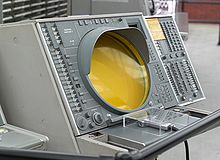- Semi-Automatic Ground Environment
-
 SAGE Sector Kontrollraum. Der Bildschirm zeigt einen Teil der US-Ostküste Cape Cod im Zentrum mit zwei aufgespürten "Zielen".
SAGE Sector Kontrollraum. Der Bildschirm zeigt einen Teil der US-Ostküste Cape Cod im Zentrum mit zwei aufgespürten "Zielen".
Semi-Automatic Ground Environment (SAGE) war das erste computergestützte Luftverteidigungssystem der NORAD. Getestet wurde es erstmals 1952, um feindliche Bomber aufzuspüren, zu verfolgen und abzufangen. Als es schließlich 1963 voll einsatzbereit war, war allerdings die Bedrohung durch sowjetische Bomber bereits derjenigen durch Raketen gewichen. Hierfür war SAGE jedoch gänzlich ungeeignet. Dennoch hatte das Projekt wesentlichen Einfluss auf die Entwicklung von Computersystemen im Bereich Echtzeitverarbeitung von Informationen und der Vernetzung über Modems.
Den Auftrag zum Bau eines Röhrencomputers auf Grundlage des vom Massachusetts Institute of Technology entwickelten Whirlwind-Projektes erhielt zunächst die Radio Corporation of America. Später ging er jedoch an IBM, die 1958 mit dem Bau des Computers begann. Der Auftrag war ein wichtiger Bestandteil des späteren Erfolges dieser Firma.
Der AN/FSQ-7 (Whirlwind II)-Röhrenrechner bestand aus 55.000 Elektronenröhren und hatte einen Ferrit-Kernspeicher. Bei einem Gewicht von 275 Tonnen belegte er eine Fläche von über 2000 m² und hatte eine Leistungsaufnahme von bis zu 3 Megawatt. Er sammelte Daten der angeschlossenen Beobachtungsstationen in Echtzeit und ermöglichte den Operatoren auf einfache Weise die Auswahl der zu bekämpfenden Ziele. Hierzu wurden dem System auch der Status von Abfangjägern aller Flughäfen des Gebietes sowie der Bomarc- oder Nike Hercules-Luftabwehrraketen übermittelt.
Da die Bediener keine Computerspezialisten, sondern einfache Soldaten waren, wurde erstmals eine komplexe Mensch-Computer-Schnittstelle entwickelt. Dabei entstanden Bildschirmsysteme für Texte und graphische Darstellungen und der Lichtgriffel als Eingabegerät für grafische Daten.
Sobald ein Ziel interessant schien und der Operator sich entschloss, es abzufangen, wurden automatisch Nachrichten über Fernschreiber an die örtlichen Verantwortlichen gesendet.
Die SAGE-Flugabwehr war bis 1979 in Betrieb und wurde dann durch neuere Systeme, später auch luftgestützte Überwachungssysteme (AWACS), abgelöst. Der letzte Rechner wurde 1983 abgeschaltet und befindet sich nun im Computermuseum in Boston. Die USA kostete das SAGE-System rund acht Milliarden US-Dollar.
Literatur
- John F. Jacobs, The SAGE Air Defense System: A Personal History (MITRE Corporation, 1986)
- R. G. Enticknap and E. F. Schuster, SAGE Data System Considerations, AIEE Transactions vol 77, pt I, 1958 (January 1959 section), pp 824-832.
- Robert R. Everett (editor), Special Issue: SAGE (Semi-Automatic Ground Environment), Annals of the History of Computing 5:4 (1983).
- Paul N. Edwards, The Closed World: Computers and the Politics of Discourse in Cold War America (Cambridge, MA: MIT Press, 1996)[1], esp. Chapter 3.
- Kent C. Redmond, Thomas M. Smith: From Whirlwind to MITRE: The R&D Story of The SAGE Air Defense Computer. MIT Press, Cambridge 2000. ISBN 0-262-18201-7
- Thomas P. Hughes, Rescuing Prometheus: Four Monumental Projects That Changed the Modern World, esp. Chapter 2. Pantheon, 1998. ISBN 0-679-41151-8
Weblinks
-
 Commons: Semi Automatic Ground Environment – Sammlung von Bildern, Videos und Audiodateien
Commons: Semi Automatic Ground Environment – Sammlung von Bildern, Videos und Audiodateien
Kategorien:- Militärische Informations- und Kommunikationstechnologie
- Radar
- Kalter Krieg
Wikimedia Foundation.

